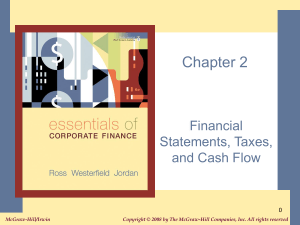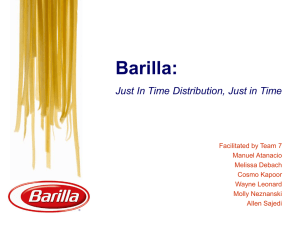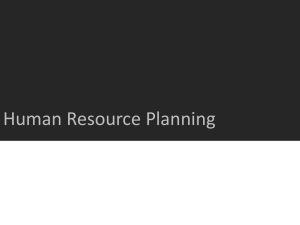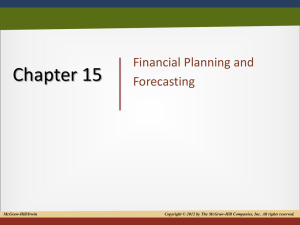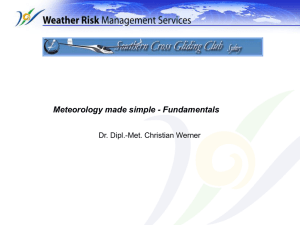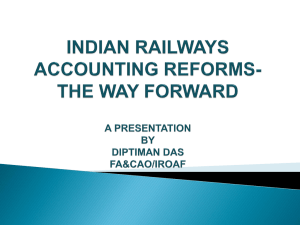+Δ NWC
advertisement
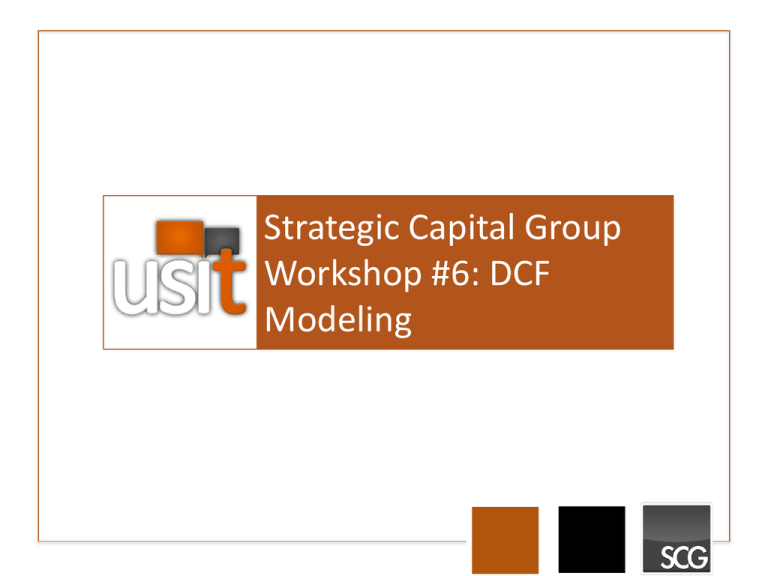
Strategic Capital Group Workshop #6: DCF Modeling Agenda Discounted Cash Flow Overview Forecasting 101 Projection Walkthrough Net Working Capital and WACC Calculating Terminal and Equity Value Walkthrough of the DCF Please open up the DCF template in excel (found on the USIT Website) Revenue -COGS Gross Profit Line Items -SG&A Expenses -R&D Expenses -Other Expenses EBIT x(1-Tax) NOPAT +D&A -CapEx +Δ NWC FCF Proxy The Idea Behind It 1.) We are converting revenue to cash (due to accounting gimmicks making metrics like revenue and net income “tainted”). 2.) We project out revenue and the subtractions required to get to cash for the period of 5 years 3.) Discount the cash flows back to present value and add them back up 4.) Calculate an enterprise value by summing the PV’d cash flows 5.) Solve for equity value 6.) Divide equity value by shares outstanding to find implied share price The First Step: Forecasting • We need to figure out what the revenues and associated costs for the next 3-5 years will be in order to find what the cash flows will be for the next five years • Goal: To create a defensible argument for our projections • Several components to forecasting Why 3-5 Years? Depends on the investment horizon you have Many times 3 years will be explicitly stated (numbers) and the next two will be analyzed but not entered. 5 years to reach a steady state – go through an economic cycle and realize any projects/initiatives Forecasting: Company Overview UNDERSTAND THE COMPANY UNDERSTAND THE COMPANY UNDERSTAND THE COMPANY Things to look at: • Management Philosophies (ex. Steve Jobs did a great job of innovating, good sign) • Products/Services (will people still use this product in the future, do people like it? Ex. NewsCorp’s print business) • Competition in the Industry (does the company risk others beating its product line ex. HP vs. Dell) • Where the company is going (Does the company want to reinvent itself? Ex. Dell moving toward enterprise and away from consumer PC’s) • What does it do? (Avoid critical mistakes like Microsoft selling PC’s, they sell OS’s, totally different markets) Forecasting: Company Overview • Where can I find this information? http://www.wikiwealth.com/swot - Company SWOT analysis (Strength, Weakness, Opportunity, Threat) 10-K and Annual report covers- Give a run down of the company, its business segments, who it sells to, what regions drive its revenue, how big it is 10-K Management Discussion & Analysis- Management gives its opinions on where it wants to take the company and its own SWOT Forecasting: Markets and Industries • Now that we’re nice and comfy with the company and know how it will make money, we need to figure out how much it will make. • We look at industry and market growth to try and understand wide trends that will benefit the company. Forecasting: Markets and Industries We have a number of sources to get information on markets and industries: -Capital IQ -FactSet -News Articles -Other industry report generating sources -academic.mintel.com These are the two best, tune into factset and CIQ workshops to learn how to use them effectively. Forecasting: Targets How do we know we’re close to picking the correct revenue amount? -Past History- typically we cap growth rates at their 5-10 year averages to be conservative. -Analyst Estimates- analysts will come out an give their forecasts for quarterly and annual revenue reporting, typically up to 5 years into the future. -MD&A- Management will typically come out set their EPS and Revenue targets for the 1-2 years in the future, then give a long term, 10 year goal. Forecasting: Targets • Past History: – Pros: give us the bounds of what a company is capable of achieving (a company that has grown only 1-2% in the past isn’t likely to see 30% YoY growth) – Cons: Past history isn’t always a measure of future performance, a new product or market can jump start aggressive growth Forecasting: Targets • Analyst Estimates: – Pros: Typically a large number of analysts that spend a lot of time tracking a company and understanding it- making some of their predictions fairly close – Cons: Some analysts work for in divisions of an Investment Bank and can be pressured to give a “buy” rating to company’s the iBank works with, so many times Analysts are a little too optimistic Forecasting: Targets • MD&A: – Pros: Since they run the company, there’s a good chance the direction they say they want to take the company is the direction it will go. Also very good at forecasting CapEx – Cons: Incentive to overstate their income and revenue predictions, typically they are a good benchmark for an aggressive prediction, rather than conservative. Forecasting: Digesting It All • So we understand the company’s offerings, where management thinks its going, where the market is going, past growth, and where analysts who have studied the company think it’s going. • We need to translate this into a growth rate. Forecasting: Digesting it All • Unfortunately there are no equations for translating qualitative information into an exact quantitative number, it’s something you have to practice and get good at. • However, we can get close to predicting a correct number. • Let’s use AAPL as an example Key Revenue Drivers • What drives revenue? – Either Price must go up, or Quantity must go up – Or new products must emerge • Most often, we model revenue based on drivers – Ex: Apple has # phones and avg. cost per phone – Ex2: WSJ has subscribers and ARPU Cost of Goods Sold • Not being able to use chinese sweatshop labor will drive up costs per phone a little, but in general it should stay constant • Most logical way would be to model it out as a percentage of revenue SG&A and R&D • We see Apple keeping its SGA& stable at its past average growth rate • SG&A is usually modeled on a constant growth rate. – Why? Why not as % revenue? – Are there parts that maybe should be % rev? Other Operating Expenses • Could be basically anything really, but obviously nothing that we already listed • No R&D, No interest or other income. Breathe! • That was more than half of the “hard stuff” • Where are we? Revenue -COGS Gross Profit -SG&A Expenses -R&D Expenses -Other Expenses EBIT x(1-Tax) NOPAT +D&A -CapEx +Δ NWC FCF Proxy Capital Expenditures • Let’s look at MD&A for a good estimate for Capital Expenditures (purchases of long-term assets, found in the statement of cash flows investing section). In non-time constrained environments we would go back and check Management’s accuracy of predictions. Capital Expenditures • As a company matures, typically its Capital Expenditures tails off • Maintenance CapEx vs Growth CapEx Depreciation • Depreciation is tied to long-term assets, (long-term assets are the only assets that generate depreciation expense, we don’t depreciate cash or accounts receivable). • We can look at a depreciation schedule in the 10k to figure out how much depreciation will come due from year to year and forecast that way, or tie it to CapEx growth (eventually D&A growth will tie to CapEx growth). • We add depreciation back to Revenue in order to eliminate non-cash expenses and get to a more accurate Free Cash Flow So where are we? • We’ve learned forecasting tools for revenues, costs, and learned the general form of a DCF’s line items. • We’ve gone over how depreciation and CapEx are forecasted and how they affect free cash flows. Change in Net Working Capital • Working Capital = Current Assets – Current Liabilities • We deal with non-cash current assets and non-interest bearing current liabilities • Represents operating liquidity of the business. • We add/ subtract this from Revenue due to the involvement of changes in current assets and liabilities to cash – We pay cash to increase current assets, and gain cash when current assets are sold, the inverse applies to liabilities • So if the change in NWC is positive, then we added more assets than liabilities so we subtract this from Revenue. If change in NWC was negative (more liabilities added than assets), this will increase the amount of cash we received during the period How do we forecast NWC? • Most often, NWC will be fairly constant as a percentage of revenue – Why? – If this isn’t the case you might have some problems • So to forecast the change, you can forecast NWC for every period and get the change that way What is the change in Net Working Capital? Cash grew from 2012 to 2013 by 200M Inventory grew from by 12M Accounts Receivable decreased by 4M Prepaid Expenses grew by 1M Accrued Liabilities grew by 8M Accounts Payable grew by 13M So what’s left? • We know what our revenue and costs will be over the next 5 years, we know NWC and the depreciation and CapEx. • We’ve reached free cash flow, but we need to figure out what the cash flows are worth today. We need to “discount” them back to the future. • But what discount rate do we use? How do we find an discount rate that reflects the diversity of risk within our specific company? That will be covered next week

